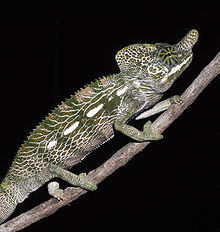
Summary
Labord's chameleon (Furcifer labordi) is a species of chameleon, a lizard in the family Chamaeleonidae. The species is endemic to dry and deciduous forests, including spiny forests, in lowlands of western Madagascar. It is considered vulnerable because of ongoing habitat loss.[1]
| Labord's chameleon | |
|---|---|

| |
| male | |
| Scientific classification | |
| Domain: | Eukaryota |
| Kingdom: | Animalia |
| Phylum: | Chordata |
| Class: | Reptilia |
| Order: | Squamata |
| Suborder: | Iguania |
| Family: | Chamaeleonidae |
| Genus: | Furcifer |
| Species: | F. labordi
|
| Binomial name | |
| Furcifer labordi (Grandidier, 1872)
| |

| |
| Synonyms[2] | |
| |
Etymology edit
The specific name, labordi, is in honor of French adventurer Jean Laborde.[3][4]
Life cycle edit
F. labordi is the only chameleon confirmed to typically–but not always–have a one-year life cycle with adults dying after having bred (they are semelparous),[5][6] although there are indications that this often also is the case for some other related species, for example F. antimena, F. campani and F. lateralis.[7]
The shortest lifespan after hatching in F. labordi is found in certain populations living in the most arid regions of the species' range.[5][6] In these, the eggs hatch synchronously at the start of the wet season in November, just after the first rains. Their initial growth after hatching is rapid, and adulthood is reached by January, at which time they breed. Between late January and late March, females deposit the eggs in the ground which will hatch the next wet seasons, and all adults die.[5][6] In such populations, they live for only about 4 to 5 months after hatching, making it the shortest lifespan ever recorded for a tetrapod vertebrate.[5][6][8]
In certain other populations that inhabit less harsh habitats with higher rainfall, hatchlings emerge from the eggs up to about one month earlier, and lifespan after hatching typically is 6 to 9 months.[6] They take longer to reach maturity after hatching and some females may breed twice in a wet season (they are not strictly semelparous).[6] Exceptionally, females in such regions may even survive through a dry season and into the following breeding seasons, thus living well past one year after hatching.[6] In contrast, males compete heavily for mating rights, often fighting other males and sometimes not feeding for days when guarding a female, and in the wild they consistently die after a breeding season. When instead kept in captivity and prevented from partaking in the strenuous competition for mating rights, males show similar lifespans as females, sometimes also exceeding one year after hatching.[6]
References edit
- ^ a b Jenkins, R.K.B.; Andreone, F.; Andriamazava, A.; Anjeriniaina, M.; Brady, L.; Glaw, F.; Griffiths, R.A.; Rabibisoa, N.; Rakotomalala, D.; Randrianantoandro, J.C.; Randrianiriana, J.; Randrianizahana , H.; Ratsoavina, F.; Robsomanitrandrasana, E. (2011). "Furcifer labordi". IUCN Red List of Threatened Species. 2011: e.T8765A12929754. doi:10.2305/IUCN.UK.2011-2.RLTS.T8765A12929754.en. Retrieved 19 November 2021.
- ^ "Furcifer labordi ". The Reptile Database. www.reptile-database.org.
- ^ Beolens, Bo; Watkins, Michael; Grayson, Michael (2011). The Eponym Dictionary of Reptiles. Baltimore: Johns Hopkins University Press. xiii + 296 pp. ISBN 978-1-4214-0135-5. (Furcifer labordi, p. 149).
- ^ Grandidier A (1872). "Descriptions de quelques Reptiles nouveaux découverts à Madagascar en 1870 ". Annales des Sciences Naturelles, Cinquième Série [Fifth Series], Zoologie et Paléontologie 15 (20): 6–11. ("Chamæleo Labordi ", new species, p. 7). (in French).
- ^ a b c d Karsten, Kristopher B.; Andriamandimbiarisoa, Laza N.; Fox, Stanley F.; Raxworthy, Christopher J. (2008-06-30). "A unique life history among tetrapods: An annual chameleon living mostly as an egg". Proceedings of the National Academy of Sciences. 105 (26): 8980–8984. Bibcode:2008PNAS..105.8980K. doi:10.1073/pnas.0802468105. ISSN 0027-8424. PMC 2449350. PMID 18591659.
- ^ a b c d e f g h Eckhardt, Falk; Kappeler, Peter M.; Kraus, Cornelia (2017). "Highly variable lifespan in an annual reptile, Labord's chameleon (Furcifer labordi )". Scientific Reports. 7 (1): 11397. Bibcode:2017NatSR...711397E. doi:10.1038/s41598-017-11701-3. PMC 5595997. PMID 28900276.
- ^ Eckhardt, Falk (2019), A short story: senescence in an annual reptile, Labord's chameleon (Furcifer labordi), University of Göttingen
- ^ Davies, Ella (2011-02-21). "Labord's chameleons of Madagascar live fast, die young". BBC Earth News. Retrieved 2017-09-28.



